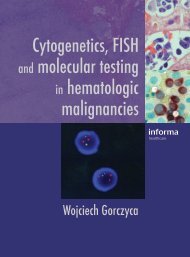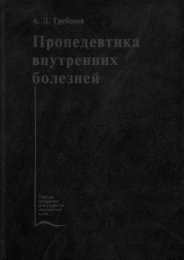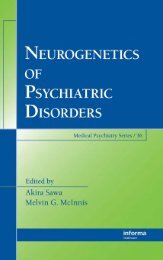Color Atlas of Hematology - Practical Microscopic and Clinical ...
Color Atlas of Hematology - Practical Microscopic and Clinical ...
Color Atlas of Hematology - Practical Microscopic and Clinical ...
- No tags were found...
Create successful ePaper yourself
Turn your PDF publications into a flip-book with our unique Google optimized e-Paper software.
132Erythrocyte <strong>and</strong> Thrombocyte AbnormalitiesTable 23Normal ranges for physiological iron <strong>and</strong> its transport proteinsOld unitsSI unitsSerum ironNewborns 150–200µg/dl 27–36µmol/lAdultsFemale 60–140µg/dl 11–25µmol/lMale 80–150µg/dl 14–27µmol/lTIBC 300–350µg/dl 54–63µmol/lTransferrin 250–450µg/dl 2.5–4.5 g/lSerum ferritinTIBC = Total iron binding capacity.30–300µg/l(15–160µg/l premenopausal)This usually renders determination <strong>of</strong> transferrin <strong>and</strong> total iron bindingcapacity (TIBC) unnecessary. If samples are being sent away to a laboratory,it is preferable to send serum produced by low-speed centrifugation,since the erythrocytes in whole blood can become mechanically damagedduring shipment <strong>and</strong> may then release iron. Table 23 shows the variation<strong>of</strong> serum iron values according to gender <strong>and</strong> age.It is important to note that acute blood loss causes normochromic anemia.Only chronic bleeding or earlier serious acute blood loss leads to irondeficiency manifested as hypochromic anemia.Iron Deficiency <strong>and</strong> Blood Cell Analysis Focusing on the erythrocyte morphologyis the quickest <strong>and</strong> most efficient way to investigate hypochromicanemia when the serum iron has dropped below normal values. In hypochromicanemia with iron <strong>and</strong> hemoglobin deficiency (whether due to insufficientiron intake or an increased physiological iron requirement),erythrocyte size <strong>and</strong> shape does not usually vary much (see Fig. 45). Only inadvanced anemias (from approx. 11 g/dl, equivalent to 6.27 mmol/l Hb)are relatively small erythrocytes (microcytes) with reduced MCV <strong>and</strong>MCH <strong>and</strong> grayish stained basophilic erythrocytes (polychromatic erythrocytes)seen, indicating inadequate hemoglobin content. Cells with theappearance <strong>of</strong> relatively large polychromatic erythrocytes are reticulocytes.The details <strong>of</strong> their morphology can be seen after supravital staining(p. 141). A few target cells (p. 139) will be seen in conditions <strong>of</strong> severe irondeficiency.In severe hemoglobin deficiency ( 8 g/dl, equivalent to 4.96 mmol/l)the residual hemoglobin is found mostly at the peripheral edge <strong>of</strong> theerythrocyte, giving the appearance <strong>of</strong> a ring-shaped erythrocyte.






